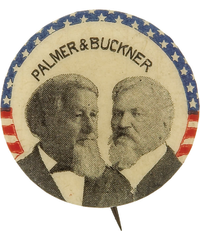National Democratic Party | |
|---|---|
 | |
| Leaders | John M. Palmer William F. Vilas Grover Cleveland Simon B. Buckner Henry K. Douglas |
| Founded | 1896 |
| Dissolved | 1900 |
| Split from | Democratic Party |
| Preceded by | Bourbon faction of the Democratic Party |
| Merged into | Democratic Party |
| Ideology | Liberalism (American) Classical liberalism Anti-imperialism Pro-gold standard |
| Political position | Center-right[1][2][3] |
| National affiliation | Democratic Party |
| Colors | Gold |
The National Democratic Party, also known as Gold Democrats, was a short-lived political party of Bourbon Democrats who opposed the regular party nominee William Jennings Bryan in the 1896 presidential election. The party was then a "liberal" party in the context of the times, which is more of a fiscal-conservative or classical-liberal in the political context of the United States today.
Most members were admirers of Grover Cleveland as they considered Bryan a dangerous man and charged that his "free silver" proposals would devastate the economy. They nominated the Democratic politicians John M. Palmer, a former Republican governor of Illinois and Union general; and Simon Bolivar Buckner, a former governor of Kentucky and Confederate general, for president and vice president, respectively.[4]
They also ran a few candidates for Congress and other offices, including William Campbell Preston Breckinridge in Kentucky and Edward S. Bragg in Wisconsin.
- ^ Rothbard, Murray N. (August 30, 2002). History of Money and Banking in the United States: The Colonial Era to World War II (PDF). Ludwig von Mises Institute. ISBN 0-945466-33-1.
- ^ McClanahan, Brion (April 7, 2009). "National Democratic Party (NDP)". Retrieved October 3, 2019.
- ^ Rothbard, Murray N. (November 9, 2017). The Progressive Era (PDF). Auburn, Alabama: Ludwig von Mises Institute. ISBN 978-1-61016-674-4.
- ^ David T. Beito, and Linda Royster Beito, 2000.
